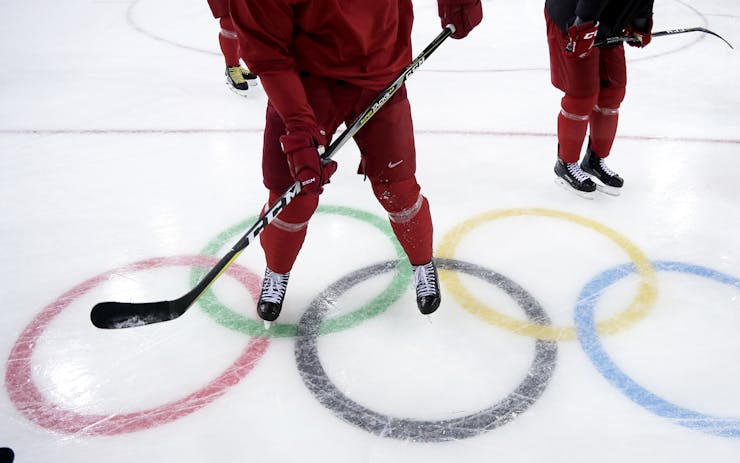Whether or not you consider cannabis a performance-enhancing substance, it’s still a no-no for Olympic athletes. Being caught can mean suspension or even the loss of a medal. Just ask Canada’s Ross Rebagliati, who in 1998 was stripped of the first-ever Olympic gold for snowboarding after his urine tested positive for THC.
Rebagliati eventually got his medal back after pointing out that cannabis at the time wasn’t actually classified as a banned substance. But every year since, cannabinoids have appeared on the official “Prohibited List” put out annually by the World Anti-Doping Agency (WADA). Sorry, brah.
That’s not to say WADA is especially strict when it comes to cannabis. In fact, the agency’s limits are probably more lenient than your employer’s.
THC
In 2016, we called the Olympic limits on cannabinoids “shockingly reasonable”—and they’ve only gotten more sensible since. Athletes’ urine must contain less than 150 nanograms per milliliter of carboxy-THC, a cannabis metabolite.
By comparison, workplace drug tests commonly used by private employers in the United States set thresholds between about 15 ng/mL and 100 ng/mL. (Rebagliati, the snowboarder, returned a result of 17.8 ng/mL.)
Legal-cannabis states often have per se limits for cannabis DUIs, but those are generally based on concentrations of active THC in whole blood rather than WADA’s test for metabolites in urine, making the limits difficult to compare directly.
WADA’s THC limit used to be just 15 ng/mL, but the agency quietly raised it in 2013. The head of the International Olympic Committee’s medical commission said at the time that the change was “a reasonable attempt at dealing with a complicated matter,” adding: “There is a big debate on it.”
How does the limit translate in terms of actual cannabis consumption? That’s hard to say for certain. How long cannabis remains in a person’s system depends consumption habits, genetics, as well as lifestyle factors such as diet and exercise. Athletes, who are generally leaner and more active than average, would likely be able to pass a test sooner than those of us watching from the couch at home.
If you’re trying to guesstimate, here’s a place to start: A 2005 review by Paul Cary, director of the Toxicology and Drug Monitoring Laboratory at University of Missouri, concluded that at the standard, 50-ng/mL cutoff, “it would be unlikely for a chronic user to produce a positive urine drug test result for longer than 10 days after the last smoking episode.” Drop that threshold to 20 ng/mL, Cary found, and that window extends to about three weeks.
In other words, to fail the test at WADA’s current 150 ng/mL limit, an athlete would have to be “a pretty dedicated cannabis consumer,” officials have said.
While Olympic drug-testing thresholds are relatively reasonable for cannabis, however, testing practices are less so—at least if you’re a top-level athlete. Some competitors are required to follow so-called whereabouts requirements that enable the agencies to conduct surprise screenings with little or no warning even during the offseason.
CBD
In September 2017, WADA removed its restriction entirely on cannabidiol (CBD), a non-intoxicating cannabinoid used widely for its therapeutic properties. That puts WADA far ahead of many parts of the world, including the United States, where the DEA has tried to claim that CBD is illegal and police in Indiana were recently advised to seize any “substance containing cannabidiol—or anything packaged as such.”
WADA’s warning around CBD is comparatively benign, simply cautioning athletes that consuming CBD could increase the likelihood of inadvertently putting THC in their bodies, which could risk a positive drug test. “Cannabidiol extracted from cannabis plants may also contain varying concentrations of THC,” the agency says, “which remains a prohibited substance.”
The ‘Therapeutic Use Exemption’
“But what about medical cannabis?” you ask. In theory, there’s an exception for that.
WADA and its US counterpart, the US Anti-Doping Agency (USADA), allow athletes to apply for therapeutic use exemptions (TUEs) that authorize them to use medications on the agency’s prohibited list. It’s essentially a doctor’s recommendation, documenting an athlete’s need to use a particular medication as part of their treatment regimen.
While WADA doesn’t go into much detail about TUEs for cannabis, USADA’s website says the agency will consider such applications—but only for limited conditions. From there, the agency sounds a lot like the federal government, noting for example that, unlike synthetic cannabinoids in pharmaceutical products such as Marinol or Cesamet, the cannabis plant itself has not been approved by the FDA. The agency then links to a one-page DEA document detailing why synthetically produced pharmaceutical cannabinoids are better than whole-plant cannabis.
At the end of the day, Olympic athletes are allowed a fair amount of leeway when it comes to cannabis test results, but they still operate in a world with scant protection for medical use. As more countries move to legalize, perhaps that will change.





